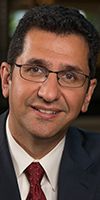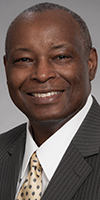|
Subscribe / Renew |
|
|
Contact Us |
|
| ► Subscribe to our Free Weekly Newsletter | |
| home | Welcome, sign in or click here to subscribe. | login |
Environment
| |
 |
September 26, 2013
At the UW, smart grids put a lid on energy use
Special to the Journal

Awad
|

Kennedy
|
Buildings account for 70 percent of the electricity draw in the United States and 40 percent of the carbon emissions. Making the built environment efficient, smart and clean is the foundation of a sustainable future and demands a range of innovative tactics to drive out waste.
For facility owners, “efficient” means minimizing energy and water consumption. Upgrading HVAC, plumbing or lighting systems allows building owners to use less to meet their daily needs. Central to efficient systems are “smart” technologies that allow operators and occupants to integrate energy-efficient behaviors with their everyday routines. “Clean” means producing more renewable energy, incorporating it into a flexible, distributed power grid, and creating opportunities for widespread access.
The challenges of improving the built environment are magnified for owners with a portfolio of facilities. These owners need accurate and timely data to make smart business decisions. Many owners choose to use enterprise energy management (EEM) systems to gather and monitor energy data across their portfolio. However, this data is rarely communicated back to utility providers, who need better information to predict loads and eliminate infrastructural inefficiencies.
Rise of the smart grid
Often referred to as the computerization of the power grid, smart grids thrive on data. Using smart meters and high-tech communication tools, utility companies and their customers engage in a two-way exchange of information. The data allows the utility company to optimize loads, which leads to improved efficiency throughout the grid and, in turn, lower prices for consumers.
Adding smart-grid technology also allows for the robust integration of clean energy into the power grid. Variability in weather makes it challenging to predict how much renewable energy will be generated at a given time. The added computerization of the smart grid allows utilities to quickly adjust to varying inputs, maximizing the use of intermittent renewable energy systems.
Smart grid demo
Since 2007, the Department of Energy has authorized billions in matching grants to fund smart-grid demonstration projects across the country. The University of Washington recently received $5.1 million of these funds to partner with Seattle City Light, the Pacific Northwest National Laboratory and McKinstry in the Pacific Northwest Smart Grid Demonstration Project, a $178 million venture spanning Washington, Oregon, Idaho, Montana and Wyoming.
Over the years, the UW has invested millions of dollars in efficiency upgrades for its facilities. The smart-grid demonstration project serves as an extension of a long-standing relationship with McKinstry, the university’s energy service partner. Until recently, however, data on the energy use of the 190 buildings across the campus was limited to monthly utility bills, giving only lagging indicators of spikes or excessive energy demand.
As part of its participation in the smart-grid demonstration project, the university installed a campus-wide EEM system with more than 500 smart meters that measure, monitor and report electricity usage in more than 11 million square feet of space. This data is warehoused and then visualized on a dashboard that can compare facilities, display historical data and identify previously hidden inefficiencies.
Other opportunities
The positive reaction from the central administration and academic units throughout the university helped the project team realize how the smart grid could be more than just a modernization opportunity. The project has spurred significant collaboration across the university, allowing student engagement in critical environmental research issues. It has transformed the campus physical plant infrastructure into a living lab by creating a large data set of real-world energy use that is highly accessible to researchers and students.
Already in the first academic quarter, three research projects involving more than 70 faculty, graduate and undergraduate students have begun. The research is broad and interdisciplinary, dealing with aspects of public policy, building engineering, sustainable design and information technology.
The smart-grid demonstration project also helps to maintain the UW’s position as a national leader in campus sustainability, which is highly valued by the student body and is key to student recruitment. As a founding signatory to the American College & University Presidents’ Climate Commitment, the UW is committed to an institutional action plan that puts it on a path to carbon neutrality by 2030.
Driving behavioral change
One of the student-led projects includes a series of experiments lead by an inter-disciplinary graduate team. Starting this fall, 200 student residents will use high-tech personal energy management dashboards and smart plugs, and will have access to floor-by-floor energy use displays, and web-based educational tools to drive energy reduction on campus residence halls. These students will participate in conservation competitions against a control group who do not have access to the technologies.
The objective of the experiment is to determine the cost and benefits of behavior-based conservation programs, to measure the persistence of behavior change over time and to evaluate the effectiveness of various technologies and educational strategies.
Future possibilities
Energy monitoring and smart grid integration are giving the University of Washington a competitive edge. With real-world data at their fingertips, student researchers can develop work-ready skills in high-demand fields while driving actual, measurable results.
The innovation occurring at the UW demonstrates that investments in efficient energy and water systems, in smart technology that allow operators and occupants to drive meaningful results, and in clean energy generation can build the leaders of tomorrow who are creating results today.
Ash Awad is vice president of Energy & Facility Services at McKinstry. Charles Kennedy is associate vice president of Facility Services at the University of Washington.
Other Stories:
- Wastewater plant cleaned up for the 21st century
- What’s next in green building? Seattle has it
- Surveys 2013: Plauche & Carr LLP
- Surveys 2013: Optimum Energy
- Surveys 2013: GeoEngineers
- Surveys 2013: Cascadia Consulting Group
- Surveys 2013: Hart Crowser
- Surveys 2013: Innovex Environmental Management
- Surveys 2013: Shannon & Wilson
- Lower your energy bill by 75% with a Passive House
- Dairies struggle to balance business and the environment
- Murky floodplain rules sink development plans
- Is your data center as green as it can be?
- Protecting Puget Sound’s marine shorelines
- Rising sea level threatens Port Gamble tribe
- Surveys 2013: Ridolfi Inc.


